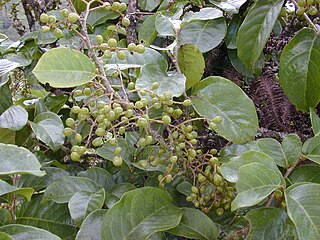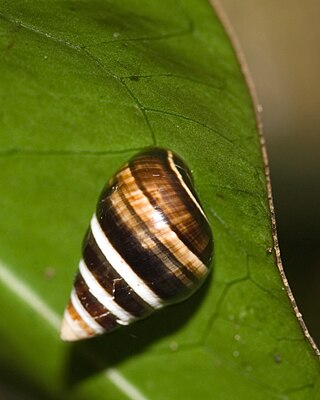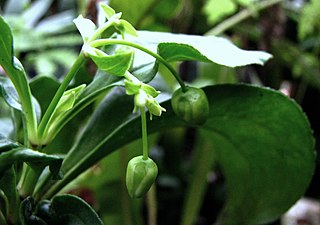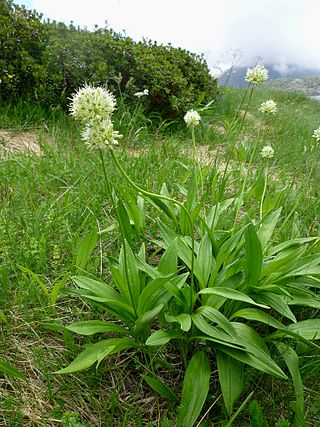
Herring are forage fish, mostly belonging to the family of Clupeidae.

The macaques constitute a genus (Macaca) of gregarious Old World monkeys of the subfamily Cercopithecinae. The 23 species of macaques inhabit ranges throughout Asia, North Africa, and Europe. Macaques are principally frugivorous, although their diet also includes seeds, leaves, flowers, and tree bark. Some species such as the long-tailed macaque will supplement their diets with small amounts of meat from shellfish, insects, and small mammals. On average, a southern pig-tailed macaque in Malaysia eats about 70 large rats each year. All macaque social groups are arranged around dominant matriarchs.

A near-threatened species is a species which has been categorized as "Near Threatened" (NT) by the International Union for Conservation of Nature (IUCN) as that may be vulnerable to endangerment in the near future, but it does not currently qualify for the threatened status.

Antidesma platyphyllum is a species of flowering tree in the leafflower family, Phyllanthaceae, that is endemic to Hawaii. Common names include hame, haʻā, mehame, hamehame, mēhamehame, and haʻāmaile. It inhabits coastal mesic forests, mixed mesic forests, wet forests, and bogs at elevations of 150–1,525 m (492–5,003 ft) on all main islands.

An IUCN Red List Critically Endangered species is one that has been categorized by the International Union for Conservation of Nature as facing an extremely high risk of extinction in the wild. As of 2021, of the 120,372 species currently tracked by the IUCN, there are 8,404 species that are considered to be Critically Endangered.

Cheirodendron is a genus of flowering plant in the family Araliaceae. All six species in the genus are endemic to Polynesia. The five Hawaiian species are generally called ʻōlapa, and occur in wet forests on all major islands as well as some mesic forests, such as Kipuka Puaulu.

The ʻanianiau is a species of Hawaiian honeycreeper that is endemic to upper elevation forests on the island of Kauai.
Oncosperma fasciculatum is a species of flowering plant in the family Arecaceae. It is found only in Sri Lanka. It is threatened by habitat loss.

Oncosperma is a genus of flowering plant in the family Arecaceae. It contains the following species, native to Southeast Asia and Sri Lanka:

Achatinella mustelina is a species of air-breathing land snail, a terrestrial pulmonate gastropod mollusc in the family Achatinellidae. This species is endemic to the Waianae Range of the island of Oahu, Hawaii.
Partulina porcellana is a species of tropical air-breathing land snail, a terrestrial pulmonate gastropod mollusk in the family Achatinellidae. This species is endemic to Hawaii in the United States. The oldest age that species in the genus Partulina reach range from 10 and 19 years.

Alsinidendron trinerve, also called three nerved alsinidendron, is a species of flowering plant in the family Caryophyllaceae, that is endemic to island of Oʻahu in Hawaii. It is a subshrub, reaching a height of 30–80 cm (12–31 in).
Melicope pallida, the pale melicope, is a species of tree in the family Rutaceae. It is endemic to the Hawaiian Islands. It is threatened by habitat loss. It is a federally listed endangered species of the United States. Like other Hawaiian Melicope, this species is known as alani.

Urera kaalae, opuhe, is a species of flowering plant in the nettle family, Urticaceae, that is endemic to the island of Oʻahu in Hawaii. It inhabits slopes and gulches in mesic forests at elevations of 300–760 m (980–2,490 ft). Currently it is restricted to the southern and central parts of the Waiʻanae Mountains. Associated plants include maile, hame, Asplenium kaulfusii, Athyrium spp., ʻāwikiwiki, pāpala, ʻakoko, poʻolā, ēlama, Doryopteris spp., ʻieʻi.e., manono, Hibiscus spp., olopua, māmaki, hala pepe, ʻālaʻa, kōpiko, heuhiuhi, aʻiaʻi, ōpuhe, and maua. It is threatened by habitat loss.

Allium victorialis, commonly known as victory onion, Alpine leek, and Alpine broad-leaf allium is a broad-leaved Eurasian species of wild onion. It is a perennial of the Amaryllis family that occurs widely in mountainous regions of Europe and parts of Asia.
Herbaspirillum rhizosphaerae is a Gram-negative mesophilic bacterium of the genus Herbaspirillum isolated from rhizosphere soil of Allium victorialis var. platyphyllum on Ulleung Island in Korea.
Lower Peirce Reservoir Park is a park located along Old Upper Thomson Road in Singapore and overlooks Lower Peirce Reservoir, Singapore's second oldest reservoir. A mature secondary rainforest lines the bank with numerous rubber trees and oil palms. A 900-metre boardwalk constructed in Nov 1998 provides an outdoor classroom for nature study and recreation in a natural forest environment. Interpretative boards on the flora and fauna in the forest serves as a guide together with bum rest, scenic view and picnic points along the route. The boardwalk was specially routed and built on existing trails to elevate the compaction and soil erosion caused by the overuse of these trails in the forest to ensure the protection floral and fauna on the forest floor.

Crepidiastrum platyphyllum, commonly called wadan (ワダン), is a species of flowering plant in the family Asteraceae. It is native to South Korea and Japan. It is the northernmost member of its genus. In Japan, it is found along the Pacific Coast in the Chiba, Kanagawa, and Shizouka prefectures, and in Tokyo. Its natural habitat is on rocky or sandy seashores, where it is adapted for dry, sunny conditions.
Sphagnum platyphyllum, the flat-leaved bogmoss, is a species of moss belonging to the family Sphagnaceae.

Limonium platyphyllum, the broad-leaved statice, or florist's sea lavender, is a species of flowering plant in the family Plumbaginaceae. It is native to the Black Sea region; Bulgaria, Romania, Ukraine, Crimea, south and east European Russia, and the Caucasus, and it has been introduced to Great Britain. A perennial halophyte 60 to 75 cm tall, it is widely available from commercial suppliers. There are a number of cultivars, including the well-known 'Violetta' which has darker petals.













